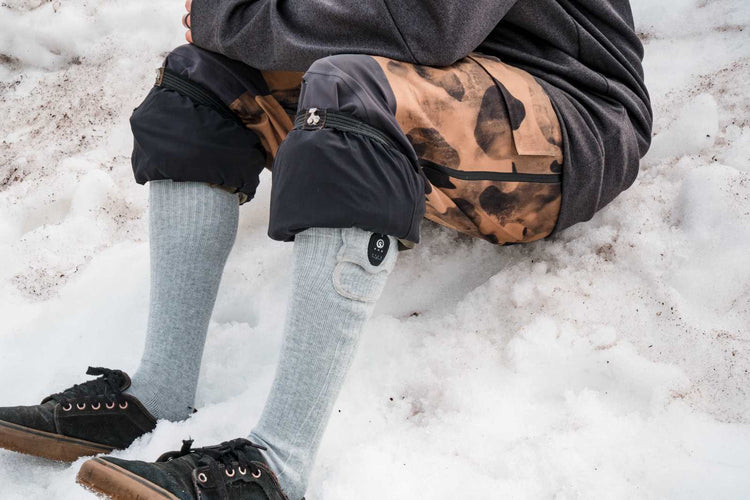Are Heated Socks Safe? Learn How to Stay Warm in the Cold Without the Worry of Overheating

Introduction
Winter’s chill can be frustrating, especially when you’re out skiing, cycling, or working outdoors. Cold feet are undoubtedly one of the biggest challenges. Many people choose to wear heated socks to combat this issue, but it often raises the question: “Do heated socks cause overheating on the feet?” If they do, that could be a problem. After all, excessive foot warmth is not a pleasant experience! In this article, we’ll explore the safety of heated socks, how to avoid overheating, and how to stay warm in the cold without worrying about overheating.

How Do Heated Socks Work? — Warm Without Overheating
Heated socks work by using built-in heating elements to transfer warmth to your feet, helping to dispel the cold. Many modern heated socks feature adjustable temperature settings, allowing you to control the warmth according to your needs and ensure your feet stay comfortable without overheating.
Temperature Control: Precise Adjustment for Comfort at Your Fingertips

The temperature control system in heated socks allows for precise adjustments based on your needs. This ensures comfort without worrying about overheating. Whether you're skiing, hiking, or out on a winter walk, the temperature control function helps you set the most comfortable temperature, avoiding discomfort due to excessive heat.
Do Heated Socks Cause Overheating?
Smart Temperature Control System: Ensuring Comfort Without Overheating
Modern heated socks come with smart temperature control systems that prevent overheating. These systems automatically adjust the temperature based on external conditions and your activity. For example, in colder environments, the socks will increase heating to match the low temperatures; whereas in warmer indoor environments, the temperature will adjust to a more comfortable level.
Overheat Protection: Safe Use, Peace of Mind
Most heated socks come with overheat protection features. When the temperature exceeds a certain threshold, the heating element automatically shuts off, preventing the temperature from rising further. This means that no matter how the external environment changes, your socks will maintain a safe temperature, avoiding discomfort.
Freely Adjust Temperature: Warmth at Your Command
One of the standout features of heated socks is the ability to adjust the warmth. You can set the temperature based on external conditions and activity levels. For extreme cold conditions like skiing, you can set the socks to the highest heat setting; for everyday outings, a lower temperature is enough. With the help of a mobile app, temperature control becomes even more flexible, ensuring you stay comfortable at all times.
Heated Socks Safety Analysis — Stay Warm Without the Worry of Overheating

Temperature Control + Overheat Protection: Comprehensive Safety Guarantee
The combination of the smart temperature control system and overheat protection ensures that the temperature stays within a safe, comfortable range. When the temperature becomes too high, the socks will automatically stop heating, preventing overheating discomfort and keeping you safe.
Breathable Fabric: Goodbye to Localized Overheating
High-quality heated socks not only provide even heating but also use breathable fabrics to keep your feet dry and comfortable. The heat is evenly distributed, preventing localized overheating. Even in cold conditions, your feet will remain warm without feeling stuffy or uncomfortable.
Battery Safety — Comprehensive Protection
The lithium-ion batteries used in heated socks are equipped with multiple safety features to prevent overcharging, overheating, or short-circuiting issues. This ensures that you can enjoy warmth and comfort without worrying about any safety concerns regarding the battery.
How to Use Heated Socks Safely?
Adjust Temperature According to Conditions
Based on external conditions and the intensity of your activity, adjust the temperature of the socks accordingly. For skiing or cold outdoor activities, use the high-temperature setting; for daily wear, the low-temperature setting will suffice. Adjusting as needed ensures that you stay warm and comfortable without worrying about overheating.
Regularly Check and Maintain
Make sure your heated socks are in optimal working condition. Regularly check the battery and cable connections, and repair or replace any parts as needed to ensure safe and effective use.
Follow the Instructions
Each pair of heated socks comes with specific instructions. Be sure to read and follow the user manual, especially for properly operating the temperature control system, charging, and storing the socks. Doing so will help you get the best experience from your heated socks.
Conclusion
In conclusion, heated socks are a great way to stay warm in the cold without worrying about overheating. With features like smart temperature control, overheat protection, and breathable materials, they ensure that your feet stay warm and comfortable even in extreme conditions. By following the proper usage instructions and adjusting the temperature to suit your environment, you can enjoy the warmth without the risk of overheating.
If you're looking for efficient heated socks, SAVIOR HEAT is an excellent choice. Their temperature control design and safety features will keep you comfortable even in cold environments. As long as you use them correctly, you don’t need to worry about overheating—just enjoy every winter adventure to the fullest!

